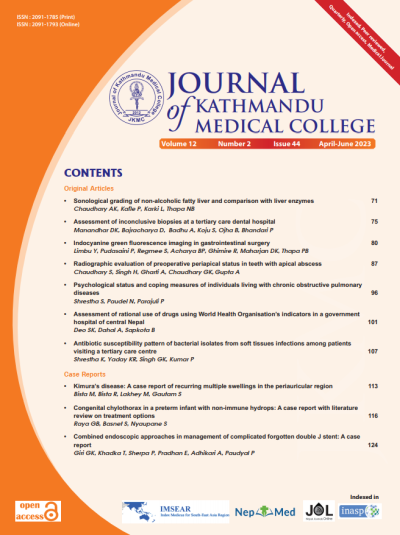Radiographic evaluation of preoperative periapical status in teeth with apical abscess
DOI:
https://doi.org/10.3126/jkmc.v12i2.53545Keywords:
Acute apical abscess, Chronic apical abscess, Periapical index, Periapical radiographs, Periapical statusAbstract
Background: The presence of preoperative periapical lesion is a significant prognostic factor that influences the outcome of endodontic treatment. Radiographic evaluation of periapical status is important for diagnosis, treatment, and prognosis of periapical lesion.
Objectives: To radiographically compare and evaluate the preoperative periapical status using periapical index (PAI) in teeth with acute and chronic apical abscess.
Methods: An analytical cross-sectional study was conducted in Chitwan Medical College, between 2022 February to 2022 May using nonprobability convenience sampling technique. Forty-eight periapical radiographs with a diagnosis of apical abscess {24 acute apical abscess (AAA) = Group 1; 24 chronic apical abscess (CAA) = Group 2)} were included for evaluation. Four observers (Three endodontists and one oral radiologist) evaluated the periapical status on radiographs and scored them according to PAI scoring system. Statistical analysis was done using the Mann-Whitney U test and SPSS v.22.
Results: The most common PAI score for teeth in Group 1 was three (13, 54.20%) with mean PAI score = 3.21 and in Group 2 the score was four (13, 54.20%) with mean PAI score = 3.79. Analysis of PAI scores found significant differences (p = 0.009, p <0.05) between groups. The distribution of PAI varied according to apical diagnosis (p <0.05). Intraobserver and Interobserver agreement values demonstrated good self-agreement and interobserver agreement.
Conclusion: Teeth with CAA were more likely to have higher PAI scores and therefore, periapical radiograph and PAI scoring system can be used effectively for the evaluation of preoperative periapical status in teeth with apical abscess.
Downloads
Downloads
Published
How to Cite
Issue
Section
License

This work is licensed under a Creative Commons Attribution-NonCommercial 4.0 International License.
Copyright © Journal of Kathmandu Medical College
The ideas and opinions expressed by authors or articles summarized, quoted, or published in full text in this journal represent only the opinions of the authors and do not necessarily reflect the official policy of Journal of Kathmandu Medical College or the institute with which the author(s) is/are affiliated, unless so specified.
Authors convey all copyright ownership, including any and all rights incidental thereto, exclusively to JKMC, in the event that such work is published by JKMC. JKMC shall own the work, including 1) copyright; 2) the right to grant permission to republish the article in whole or in part, with or without fee; 3) the right to produce preprints or reprints and translate into languages other than English for sale or free distribution; and 4) the right to republish the work in a collection of articles in any other mechanical or electronic format.




